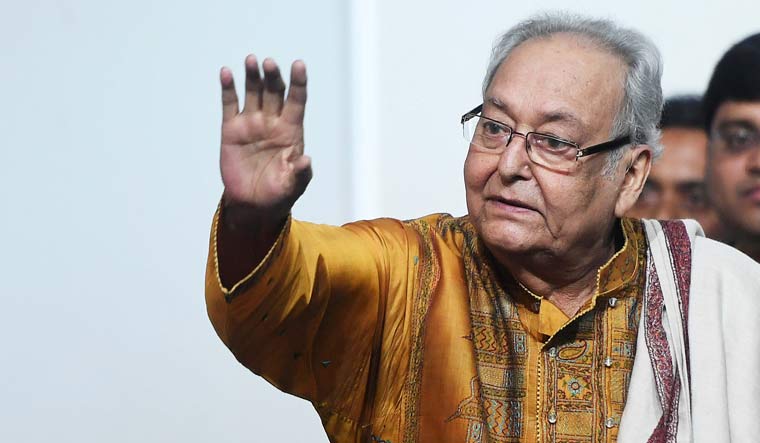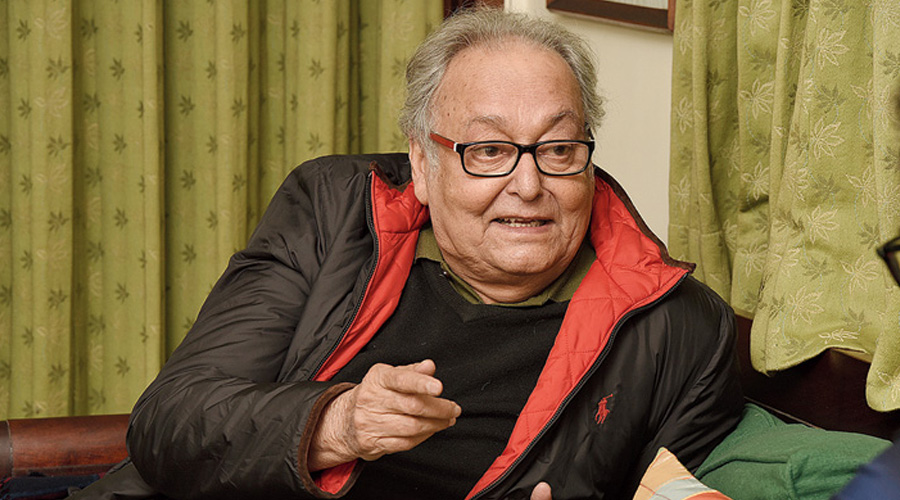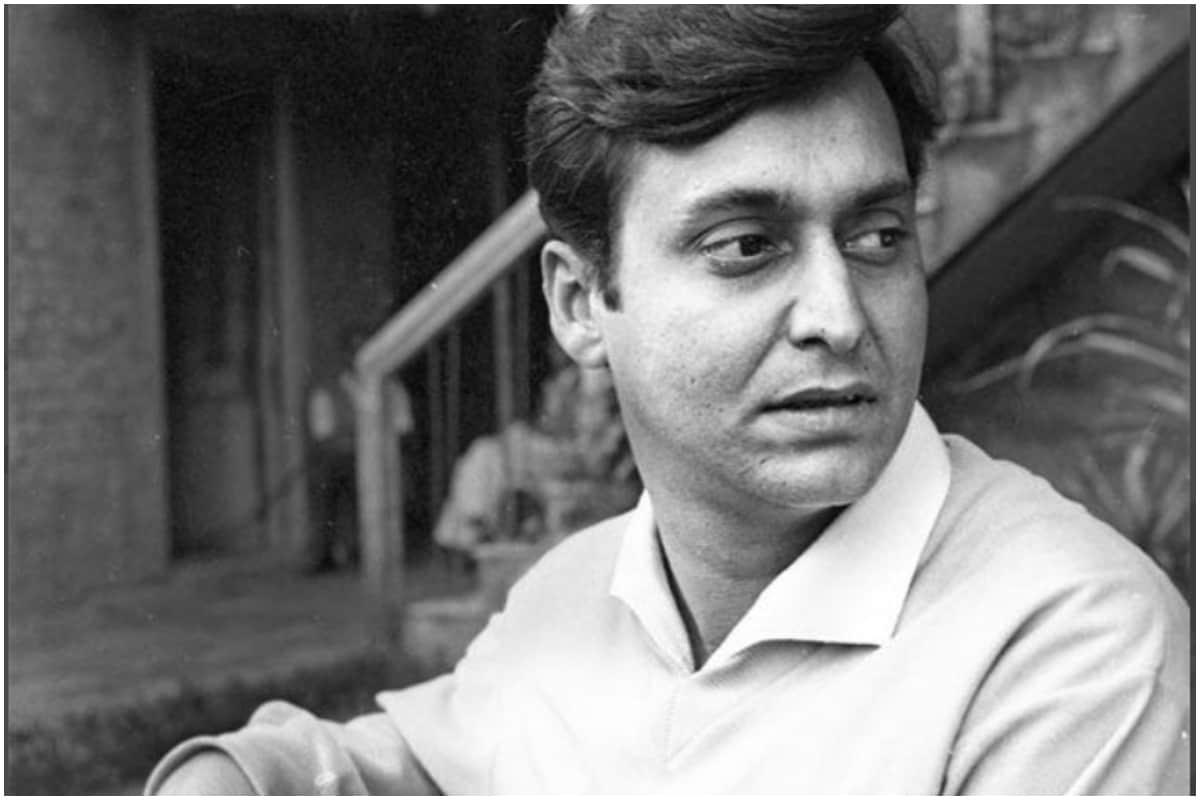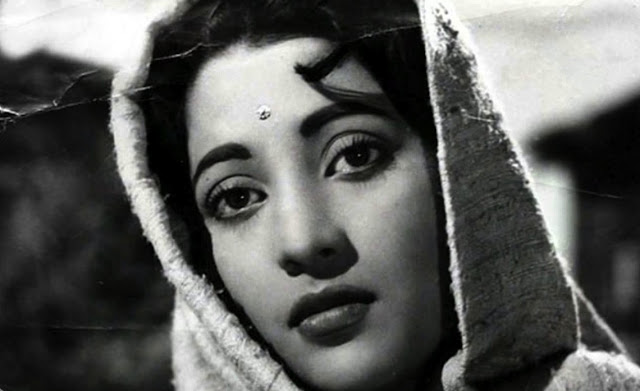Soumitra Chatterjee
Soumitra Chatterjee (also spelled as Chattopadhyay;
19 January 1935 – 15 November 2020) was an Indian
film actor, director, playwright, writer, and poet. He is best known for
his collaborations with director Satyajit Ray, with whom he worked in
fourteen films.
Starting with his debut film, Apur Sansar (The World of
Apu, 1959), the third part of The Apu Trilogy, as adult Apu,
he went on to work in several films with Ray, including Abhijan (The expedition, 1962), Charulata (The Lonely Wife, 1964), Aranyer
Din Ratri (Days and Nights in the Forest, 1969), Ashani Sanket (Distant
Thunder, 1973), Sonar Kella (The Fortress, 1974), and Joi
Baba Felunath (The Elephant God, 1978) as Feluda, Hirak
Rajar Deshe (1980), Ghare Baire (The Home and The
World, 1984), Shakha Proshakha (1990), and Ganashatru (Enemy
of the People, 1989).
He also worked with other noted directors of Bengali cinema, such
as Mrinal Sen in Akash Kusum (Up in the Clouds,
1965); Tapan Sinha in Kshudhita Pashan (Hungry Stones,
1960), Jhinder Bandi (1961); Asit Sen in Swaralipi (1961), Ajoy
Kar in Parineeta (1969), and Tarun
Mazumdar in Ganadevata (1978). He acted in more than 210
films in his career. He also received critical acclaim for his directorial
debut Stree Ki Patra (1986) which was based on
the Bengali short story Streer Patra by Rabindranath
Tagore.
Chatterjee was the recipient of multiple honors and awards. Chatterjee
was the first Indian film personality who was conferred with France's highest
award for artists, Ordre des Arts et des Lettres (1999). He
was also awarded the Padma Bhushan (2004) and France's highest
civilian award Chevalier de la Legion d'honneur (2017). He
received two National Film Awards as an actor and the Sangeet
Natak Akademi Award for his work in theatre. In 2012, he received
the Dadasaheb Phalke Award, India's highest award in cinema given by
the government of India for lifetime achievement. In 2013, IBN
Live named him as one of "The men who changed the face of the Indian
Cinema".
Early
life and background
Soumitra was born in Mirzapur Street (now Surya Sen Street)
near Sealdah railway station, in Calcutta in 1935. The first ten
years of his early life were spent in Krishnanagar in West
Bengal. The town under the influence of playwright Dwijendralal Ray, also
from Krishnanagar, had a flourishing theatre culture, with numerous small
theatre groups. His grandfather was the president of one such group while his
father, though a lawyer by profession and later a government worker, also worked
as an amateur actor. Encouraged by the praise he received for his acting in
school plays, gradually his interest in theatre grew with passing years. He was a very close friend of famous theatre
personality, Mrityunjay Sil who is often regarded as a key influence on his
career.
Soumitra and his family moved to Howrah where he studied at
the Howrah Zilla School and Calcutta during his early years. Soumitra
graduated from the City College, Kolkata with honors in Bengali
literature, as a graduating student of the University of Calcutta. He
lived for a few years in Calcutta in Satyajit Ray's old apartment at
3-lake temple road. He studied for his M.A. in Bengali from
the University of Calcutta. While still a student, he learned acting under
noted actor-director of Bengali theatre Ahindra Choudhury. However, a turning point came when in the final year of college he saw a play
by Sisir Bhaduri, theatre director and the doyen of Bengali theatre. The
play not only set a standard for acting for him but also helped make up his
mind to become an actor. He managed to meet Bhaduri, through his friend's
mother, actress Shefalika Putul. Though he met Bhaduri, towards the end of his
career, when his theatre had closed, nevertheless over the next three years,
till Bhaduri's death in 1959, Chatterjee made him a mentor and learned the
craft of acting through their regular interactions. He even appeared in a
small role in one of Bhaduri's productions.
Subsequently, he started his career working in All India
Radio as an announcer, While he was there he started pursuing a
career in films. He came in touch with Ray during the casting for Aparajito (1956),
who was looking for new faces. Ray thought he had the right look, however, found
him, age 20, and just out of college, too old for the role of
adolescent Apu. Ray remembered him and offered him the role of adult Apu
two years later. Meanwhile, he was rejected in his screen test for the Bengali
film, Nilachale Mahaprabhu (1957) directed by Kartik
Chattopadhyay.

Career
Work with
Satyajit Ray: 1959–1990
Chatterjee had gone on the sets of Ray's fourth film, Jalsaghar (1958)
to watch the shoot. He was unaware that he had already been selected for the
title role in the Apu trilogy. That day, while he was leaving the sets, Ray
called him over and introduced him to actor Chhabi Biswas as
"This is Soumitra Chattopadhyay; he's playing Apu in my next film Apur
Sansar" leaving him much surprised. Despite being selected, as a
debutant actor, Chatterjee was nevertheless unsure of his career choice and
especially his looks, as he didn't consider himself photogenic. However, on 9
August 1958, when the first shooting of the film was accepted in a single take,
he realized that he had found his vocation. Thus Soumitra's film debut
came in 1959 in Satyajit Ray's The World of Apu (Apur
Sansar). In fact, Ray believed with a beard Chatterjee looked like young poet
laureate Tagore.
Soumitra would go on to collaborate with Ray in fourteen films. His
centrality to Ray's work is akin to other key collaborations in the history of
cinema — Toshiro Mifune and Akira Kurosawa, Marcello
Mastroianni and Federico Fellini, De Niro and Martin
Scorsese, Leonardo DiCaprio and Martin Scorsese, Max von
Sydow and Ingmar Bergman, Jerzy Stuhr and Krzysztof
Kieślowski, Klaus Kinski and Werner Herzog. After Apur
Sansar, he also worked with Sharmila Tagore in a number of Ray's
films, apart from working with leading star actor of the period, Uttam
Kumar, with whom he has often been compared, in eight films.
Chatterjee was cast in diverse roles by Ray and some of the stories and
screenplays that Ray wrote were said to be written with him in mind. Soumitra
featured as Feluda/Pradosh Chandra Mitter, the famous private
investigator from Calcutta in Ray's Feluda series of books, in
two films in the 1970s Sonar Kella (1974) and Joi Baba
Felunath (1979). These two films were the first film
series made for Feluda and are considered the Feluda
original film series. He was the first person who portrayed the
iconic Bengali sleuth Feluda. Satyajit Ray made some
illustrations of Feluda based on Soumitra's body figure and look in
the 1970s Feluda books. After him, Sabyasachi Chakrabarty took
the role of the iconic Bengali hero Feluda in the mid-1990s.
Soumitra had approached Satyajit Ray to suggest a name for a little
magazine founded by Soumitra and Nirmalya Acharya in 1961. Satyajit
Ray had named the magazine Ekkhon (Now), he designed the
inaugural cover page and illustrated the cover pages regularly even after
Soumitra had stopped editing the magazine. Nirmalya continued editing the
magazine, and several of Ray's scripts were published in the magazine.
Other
works
Besides working with Ray, Soumitra excelled in collaborations with other
well-known Bengali directors such as Mrinal Sen and Tapan Sinha.
He earned critical acclaim for his role of an impostor in Mrinal Sen's Akash
Kusum (1965). He was equally confident in playing the swashbuckling
horse-riding villain in Tapan Sinha's Jhinder Bandi (1961)
giving the legendary Uttam Kumar a tough challenge. In the romantic
film Teen Bhubaner Pare (1969), he shared the screen with
actress Tanuja, the film was noted for his "flamboyant" style of
acting. Besides films, Chatterjee continued acting in Kolkata-based Bengali
theatre, and also published over 12 poetry books.
Entering the 1980s and 1990s, he started working with contemporary
directors, like Goutam Ghose, Aparna Sen, Anjan
Das and Rituparno Ghosh, and even acted on television. In 1986, he
played the role of a swimming coach in the film Kony (1986)
directed by Saroj Dey, who was part of the film collective Agragami. The
film is about a young girl from a slum, who wants to become a swimmer. At
the 32nd National Film Awards, the film won the National Film Award
for Best Popular Film Providing Wholesome Entertainment. Later in 2012
interview, he called Kony one of the best films of his career. He even recalled
using the film's catch-phrase "Fight-Koni-fight" in hard times, as a
chant to himself to lift his "aging spirits". The phrase had become
popular with middle-class Bengalis at the time.
Theatre
He replaced Mrityunjay Sil as the lead artist in 1958. Mrityunjay Sil
was at the peak of his theatre career at that time. But due to personal issues, he suggested his friend, Soumitra's name. Mrityunjay Sil is often credited with
being one of the few people to have helped Soumitra. But he soon left his job.
After a two-decade-long busy career as a leading man of Bengali cinema,
he returned to the theatre in 1978, with his production Naam Jiban,
staged at Biswarupa Theatre in Kolkata. This led to other plays like Rajkumar (1982), Phera (1987), Nilkantha (1988), Ghatak
Biday (1990) and Nyaymurti (1996), besides notable
plays like Tiktiki (1995), an adaptation of Sleuth and Homapakhi (2006).
Besides acting, he has written and directed several plays, translated a few and
also branched out to poetry reading in recent decades.
Since November 2010, he regularly performed in the title role of the
play Raja Lear directed by Suman Mukhopadhyay, a play
based on King Lear by William Shakespeare. Soumitra received
widespread critical and popular accolades for his acting in the play.

Awards
and recognition
Chatterjee received the 'Officier
des Arts et Metiers, the highest award for arts given by
the French government in 1999, and the Lifetime Award at the Naples
Film Festival, Italy. He turned down the Padma Shri award from
the Indian government in the 1970s. In 2004, he accepted the
prestigious Padma Bhushan award from the President of
India. He has been the subject of a full-length documentary named Gaach by
French film director Catherine Berge. In 1998, he was awarded the Sangeet
Natak Akademi Award is given by the Sangeet Natak Akademi, India's
National Academy of Music, Dance & Drama.
Incidentally, besides receiving eight awards from the Bengal Film
Journalists' Association for the best actor and international
recognition for his acting prowess, Chatterjee never won a National Film Award
for acting in the early part of his career, which established his reputation as
an actor, working with directors like Satyajit Ray, Tapan Sinha, and Mrinal Sen.
Thus, over the years, he has been vocal about his feelings of disappointment
and alleging bias in the National Film Awards committee towards
awarding popular and mainstream cinema. Thus, in a gesture of protest
against, he turned down the 2001 Special Jury Award for Dekha directed
by Goutam Ghose. Later in an interview, he stated "the National Film
Awards overlooked my performances in several powerful roles. When I did Kony, Shashi
Kapoor was adjudged the best actor. Anil Kapoor was feted (Best
Actor) for Pukar while Dekha was awarded a
'consolation' prize".
However, after receiving the Padma Bhushan, the third-highest civilian
honor given by Government of India in 2004, he changed his viewpoint towards
awards, and stated "Now (after Padma Bhushan) I feel I don't have the
right to hurt my viewers by rejecting an award." A few years later,
on 9 June 2008, he was awarded the 2007 National Film Award for Best
Actor for Podokkhep (Footsteps) (2006), which he
accepted through stating "after decades of acting, I do not attach too much
value to it".
In 2010, he won Best Supporting Actor at 54th Asia-Pacific Film Festival for
his role in Angshumaner Chhobi (2009).
In 2012, he was awarded the Dadasaheb Phalke Award, India's highest
award in cinema given annually by the Government of India for a lifetime
contribution to Indian cinema. In 2014, he received the
introductory Filmfare Awards East for Best Male Actor
(Critics) for his role in Rupkatha Noy and also he
won Filmfare Lifetime Achievement Award – South (1994).





























